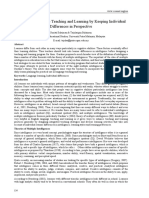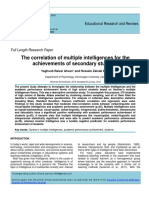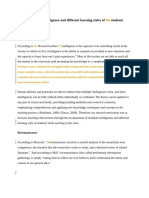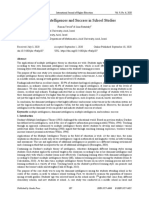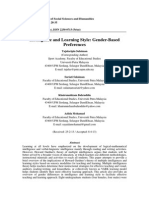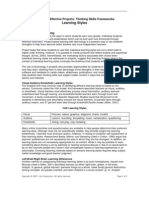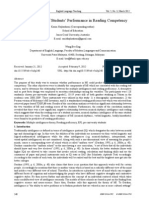The Effects of Multiple Intelligence Theory Based Teaching On Students' Achievement and Retention of Knowledge (Example of The Enzymes Subject)
The Effects of Multiple Intelligence Theory Based Teaching On Students' Achievement and Retention of Knowledge (Example of The Enzymes Subject)
Uploaded by
Surya FahroziCopyright:
Available Formats
The Effects of Multiple Intelligence Theory Based Teaching On Students' Achievement and Retention of Knowledge (Example of The Enzymes Subject)
The Effects of Multiple Intelligence Theory Based Teaching On Students' Achievement and Retention of Knowledge (Example of The Enzymes Subject)
Uploaded by
Surya FahroziOriginal Title
Copyright
Available Formats
Share this document
Did you find this document useful?
Is this content inappropriate?
Copyright:
Available Formats
The Effects of Multiple Intelligence Theory Based Teaching On Students' Achievement and Retention of Knowledge (Example of The Enzymes Subject)
The Effects of Multiple Intelligence Theory Based Teaching On Students' Achievement and Retention of Knowledge (Example of The Enzymes Subject)
Uploaded by
Surya FahroziCopyright:
Available Formats
International Journal on New Trends in Education and Their Implications July 2013 Volume: 4 Issue: 3 Article: 04 ISSN 1309-6249
THE EFFECTS OF MULTIPLE INTELLIGENCE THEORY BASED TEACHING ON STUDENTS ACHIEVEMENT AND RETENTION OF KNOWLEDGE (EXAMPLE OF THE ENZYMES SUBJECT)
Assist. Prof. Dr.Sibel GRBZOLU YALMANCI Kafkas University, Faculty of Education Department of Secondary Science Education Kars,TURKEY Ph. D. Candidate Ali brahim Can GZM Kafkas University, Faculty of Education Department of Primary Preschool Education Kars,TURKEY ABSTRACT The purpose of this study is to compare theory of multiple intelligences with the traditional education method by looking at the science teachers success, permanence of their information about enzyme subject. The research is experimental and it was carried out during 2010-2011 education year of Faculty of Education of Kafkas University, on Science Departments third grade students. In this research two impartial groups were formed and these two groups were used as control and experiment group. There were 30 students in control group and 30 students in experiment group. During the application, the lessons were given traditionally in control group, and in the experiment group; lessons were given according to multiple intelligence method. In the research, before application, the information level of students about enzyme was measured. After application the increase of their information was measured and four weeks later a success test was formed to determine the permanence of information. In the research a SPSS 16.0 package program was used to analyze the datum. To compare the students points from pretest and difference of arithmetic average of an unrelated t test and experiment were used. For comparing control groups last test and performance test ; Anova test statistics was applied. To determine the meaningful distinction after Anova test, Benforroni test was applied. In the research; the significance level was .05 In the pre-test results before the beginning of application nomeaningful distinction was found between experiment and control group according to t test. After the application ; in the last test and permanence test, multiple intelligence method which was applied on experiment group has a meaningful distinction compared to traditional education method applied on control group. Key Words: Multiple Intelligence Theory, Enzymes, Knowledge Retention, Biology Training.
INRODUCTION Today, what can an individual do is more widely thought than what he does with the advances in the field of education and psychology. Multiple intelligence theory has been proposed to consider new training methods for his purpose. (Kirk, 2003).After reviewing traditional intelligence approach, Neuropsychology and development expert Gardner proposed for the first time seven different universal capacity in his book Frames Of Mind which was published in 1983 (Lash, 2004).In 1983, Gardner set forth that any individual has a variety of intelligence degree (mathematical-logical, verbal-linguistic, musical-rhythmic, bodily-kinesthetic, intrapersonal, social, visual-spatial and nature); and this revealed multiple intelligence theory which describes the learning styles, interests, capabilities and tendencies of individuals. (Ik, 2007).Howard Gardner initially prepared a list of seven types of intelligence. The first two of these are verbal- mathematical intelligence which are very precious at school, the next three (musical-rhythmic, bodily-kinesthetic, visual-spatial) are
27 Copyright International Journal on New Trends in Education and Their Implications / www.ijonte.org
International Journal on New Trends in Education and Their Implications July 2013 Volume: 4 Issue: 3 Article: 04 ISSN 1309-6249
related to the artistic skills and the last two (internal, social) have been called as personal intelligence by Gardner (Gardner, 1999 ). Finally, he added the naturalist intelligence. Verbal-Linguistic intelligence is a kind of language capacity to achieve an aim and capability to use language learning ability in terms of writing and speaking effectively (Gndeli, 2006). Logical mathematical intelligence is a capability type for making mathematical calculation, deductive and inductive reasoning, building logical relationships, generating hypothesis, solving problem, making critical thinking and understanding numbers, geometric shapes and abstract symbols. (Vural, 2004). Visual spatial intelligence is an ability type for spatial representation of individual mind or shaping dreams , thinking with pictures, images, shapes and lines, perceiving and comprehending three dimensional objects (Byksalan, 2003; Gardner, 2006). Musicalrhythmic intelligence is instrument playing, singing and song writing ability with the basic components of music (melody, rhythm, tempo, freedom, harmony and music forms etc.) Recognition and use of rhythmic and tonal concepts include sensivity capabilities toward sounds from the environment and music instrument (Bykalan 2003; uhadar,2006). Bodily kinesthetic intelligence is the capacity of expressing oneself with movements, gestures and facial expressions, using the effective coordination of brain and body , creating a product using the whole body or a part of the whole body (Bykalan, 2003; Gardner, 2006). Interpersonal (social) intelligence is the capacity of understanding, distinguishing and welcoming the emotions, aspirations and needs of surrounding people (Tan, 2008). Intrapersonal intelligence, according to Gardner, is the most important intelligence type of daily life, which enables oneself to have knowledge and take responsibility of his own life (Demirel, 2000). Naturalistic intelligence is the ability of recognizing and researching all living things in nature and thinking on their creation (MEB, 2009). Gardner mentioned two important advantages of multiple intelligence in education. They are: It gives the opportunity to plan our education program so as to make the students desired. (For example, musician and scientific training) It enables us to reach more students trying to learn different disciplines and theories. Learning would be realized much easily on condition that students are trained by using these intelligence fields (Bmen, 2004). The two learning disciplines which multiple intelligence theory has put over the top are learning by doing and experiencing and the discipline of organizing teaching status according to students capabilities (Tan, 2006). While Gardner was submitting the features related to multiple intelligence theory and scientific evidences, he largely relied on brain research and neuropsychology. Thus, the theory has been accepted unquestionably great. Brain research has shown that each intelligence type takes place only in a specific part of the brain (Seluk, Kayl, Okut, 2003). Multiple intelligence theory puts forward that every human being has one or more mental space unique to himself and he learns more easily in accordance with this mental space. This theory is considered to enable different learning environments to access information, to have an impact on endearing the subject and to arouse interest. Multiple intelligence theory based teaching in science courses have a great role in creating active learning environment for students. The main principle of multiple intelligence theory is to cater to different intelligence area of each student. To ensure that students are able to create links among the information adopted, it is required to use teaching methods and techniques toward multiple intelligence theory. It is required to organize learning environment in an encouraging style as students participation, success, and knowledge internalizing are expected. Depending on this fact, it is quite important to apply multiple intelligence theory in science and technology teaching (Evrekli, Aydn, Balm, 2006). 28 Copyright International Journal on New Trends in Education and Their Implications / www.ijonte.org
International Journal on New Trends in Education and Their Implications July 2013 Volume: 4 Issue: 3 Article: 04 ISSN 1309-6249
The greatest impact of the theory in the process of teaching is to increase the creativity of teachers in developing teaching strategies. Because, when teachers and planners think activities for each intelligence type, they inevitably enlarge their method and technique repertoire, reveal different and original techniques. As different intelligence types are used in classroom activities during that process, cooperation is possible between the teachers whose expertise areas are completely different from each other. For example, one needs to communicate and get advice of music teacher while planning an activity related to musical intelligence (Demirel, 2000). Every child has strong and weak sides no matter what his intelligence area is. On condition that only one or two of these intelligence areas are used, the students whose intelligence types dont take place among the ones used at school cannot be able to improve their brilliant sides, complete learning in a long period without enjoying or never manage to learn. Consulting the relevant literature, it is possible to come across with several research which emphasize determining intelligence types and the impact of a subject discussed according to multiple intelligence theory on student success, knowledge permanence and attitude (Dilek Sezer, 2008; Etli, 2007; Furnham, Sahahidi and Baluch 2002, Gney, 2007; Gk Altun, 2006; Hoerr 1994; Ribot, 2004; Shore, 2004). In this study, the subject of enzymes of biology course was submitted to students with teaching techniques planned according to multiple intelligence theory, and determining the impact of this study on student success was aimed. Depending on the purpose, answers to the following sub-problems were tried to be found. 1. Is there a meaningful difference between pretest points of experiment group to whom the subject of enzymes was taught according to multiple intelligence theory and control group to whom the same subject was discussed according to traditional methods? 2. Is there a meaningful difference between pretest-posttest points and permanence test points of experiment group to whom subject of enzymes was taught according to multiple intelligence theory? 3. Is there a meaningful difference between pretest- posttest points and permanence test points of control group to whom the subject enzymes was taught according to traditional methods? METHOD Research Model In this study, nonequivalent groups pretest posttest model was used in the scope of quasi experimental method based on neutral determination of groups so as to research the effect of multiple intelligence theory based activities. (McMillan and Schumacher, 2006). In nonequivalent groups pretest posttest model, there are two groups formed by neutral assigning. One of them is referred as experimental group an the other is called as control group. In each group, pretest and posttest measurements are performed. (Karasar, 2008). Universe and Sample The study was carried with 60 teacher candidates of third grade students of Science Teaching department, at which enzymes were studied in the scope of Science Teaching as a part of curriculum. In the study, two classes were used as control and experimental group formed by neutral assigning.
29 Copyright International Journal on New Trends in Education and Their Implications / www.ijonte.org
International Journal on New Trends in Education and Their Implications July 2013 Volume: 4 Issue: 3 Article: 04 ISSN 1309-6249
Data Collection Tool Success Test Success test was developed in the research to measure to what extent the students gained behaviors as long as in the issue of enzymes is concerned. In the success test, 35 questions were prepared for each unit covering any behavior aimed to be taught. The questions were examined by biology and education sciences experts. The test was applied to 86 people who studied the subject of enzymes at university level. At the end of pilot application, selectivity indexes of test articles, article severity degree and Croncbah Alpha reliability coefficient were found and on this basis, the articles whose assessment were weak were taken out of the test. There are 30 questions in the end of the test. General reliability coefficient assessed for success test is =.80.The statement that depending on Alpha coefficient, the scale is highly reliable is used. According to Kalayc (2008), on condition that Alpha record is between 0.80-1.00, the scale is highly reliable. Besides, there are questions related to five of Blooms cognitive scale ( knowledge, understanding, application, analysis and assessment). Application The application was practiced during 2010-2011 education year at the department of Science Teaching of Kafkas University on 60 students attending third grade. During application period, the courses were discussed with traditional method on control group while it was studied according to multiple intelligence theory on experimental group by the researcher. Activities were organized for each intelligence area. The activities are shown below. Table 1: The table of activities in the issue of enzymes based on multiple intelligence theory. Intelligence Area Verbal Linguistic Intelligence Logical Mathematical Intelligence Visiual Intelligence Area Musical Intelligence Area Bodily- Kinesthetic Intelligence Area Social Intelligence Nature Intelligence Intrapersonal Intelligence Area Activity Writing and reading studies, enabling students to make comments. Problem solving, conducting an experiment, puzzle solving. Visual Presentations , Materials, Power Point Making Power Point Presentation in company with Enzymes Music. Making animations with body. Knowledge exchange, Cooperated workshops, Group Discussing Answering the question of what would happen if there were no enzymes? Explaining where the enzymes are used. Realizing the importance of enzymes for all living creatures and searching for answers to the question of why in the experiments.
For both control and experimental group, pretest at the beginning of the unit, posttest at the end of the unit and retention test after 4 weeks were applied. For the purpose of comparing student success points, these tests consist of same questions. Data Analysis In this research, an unrelated t-test in order to compare the students' scores obtained from pre-test and retention tests, and one-way Anova statistics in order to compare the groups within themselves and with one another for repetitive measurements have been applied. The Tukey test has been performed so as to determine among which groups the significant differences have been observed as a result of the Anova test.
30 Copyright International Journal on New Trends in Education and Their Implications / www.ijonte.org
International Journal on New Trends in Education and Their Implications July 2013 Volume: 4 Issue: 3 Article: 04 ISSN 1309-6249
FINDINGS AND INTERPRETATION Evidence of the First Sub-Problem The first sub-problem of the study is in the form of, "Is there any significant difference between the pre-test score averages of experimental group in which the issue of enzymes is discussed based on the multiple intelligence theory and of the control group in which the same issue is discussed through traditional methods?" In order to assess this sub-problem, a t-test has been performed between the pre-test scores of the students belong to control and experimental groups which have been applied at the beginning of the unit. Results are shown in Table 2. Table 2: The t-test chart of the scores obtained from achievement pre-test. Test Pre-test Groups Control Experimental N 30 30 Average 10.86 11.10 S 1.19 1.93 sd 58 t .56 p .57
As a result of the t-test, there is no significant difference between the achievement pre-test scores of the experimental group receiving Multiple Intelligences Theory-based education and of the students of the control group receiving a traditional education, which have been performed before the unit begins [t (58)=56, p>.05; Levene Statistics=2.06, p=.15]. The levels of the two groups are consentaneous. This situation has facilitated the implementation of the achievement test to both of the groups in terms of the perception of differences as a result of the practices. It can be said that there is no disparity of success between the students of control and experimental groups in the sense of the issue of enzymes before the implementation. Evidence of the Second Sub-Problem The second sub-problem of the research is, "Is there any significant difference between the mean scores of pretest, pro-test and retention test of the experimental group that discuss the issue of enzymes using the theory of Multiple Intelligences?" The table concerning the ANOVA statistics so as to determine whether there is significant difference between these tests is given below. Table 3: One-way ANOVA test table for repetitive measures concerning the experimental group students' pretest, post-test and retention test scores Source of Variance Among subjects Measurement Error Total Total of squares 449,789 622,156 1073,844 2145,789 sd 29 2 58 89 Average of squares 15,510 311,078 18,515 F 16,802 P* .000 Significant Difference** 2-1,3-1
* Important at p <.05 level. ** Measurements in which differences have been observed as a result of Tukey test. According to Table 3, there is a significant difference between the scores of the experimental group in pre-test (1), pro-test (2) and retention test (3) [F (2,58)= 16.802, p<0.05]. As a result of the Tukey test, a statistically significant difference has been observed between the pre-test - pro-test and pre-test - retention test of the experimental group (p <0.05).
31 Copyright International Journal on New Trends in Education and Their Implications / www.ijonte.org
International Journal on New Trends in Education and Their Implications July 2013 Volume: 4 Issue: 3 Article: 04 ISSN 1309-6249
Table 4: The arithmetic mean and standard deviations of the experimental group students' pre-test, post-test and retention test Tests Pre-test Pro-test Retention Test N 30 30 30 Average 11.10 16.86 16.46 SS 1.93 4.96 4.91
In Table 4, it can be seen that the experimental group students' mean score of post-test (x = 16.86) and the mean score of retention test (x = 16:46), are higher than the mean score of pre-test (x = 10.11). In addition, no difference has been observed between the post-test and retention test according to the Tukey test. In this case, when the averages are taken into consideration, the post-test scores of students have increased compared to the pre-test scores; therefore, it can be said that the students have learned the subject of enzymes being discussed according to the Multiple Intelligence Theory. It has been observed that the success levels after the implementation have not changed in accordance with the scores obtained from the retention test, so it can be said that the effect of the implementations based on Multiple Intelligence Theory continues. Evidence of the Third Sub-Problem and Interpretation The third sub-problem of the research is: "Is there any significant difference between the pre-test and pro-test - retention test mean scores of the control group that discuss the issue of enzymes using the theory of Multiple Intelligences?" The table concerning The ANOVA statistics so as to determine whether there is significant difference between these tests is given below. Table 5: ANOVA test chart concerning the control group students' pre-test, post-test and retention test scores Source of Variance Among subjects Measurement Error Total Total of squares 254,233 56,267 288,400 598,900 sd 29 2 58 89 Average of squares 8,767 28,133 4,972 F 5,658 P* .000 Significant Difference** 2-1
* Important at P <.05 level. ** Measurements in which differences have been observed as a result of Tukey test. According to Table 5, there is a significant difference between the scores of the groups in pre-test (1), pro-test (2) and retention test (3) [F (2,58)= 5,658, p<0.05]. As a result of the Tukey test, it has been observed that this difference takes part between the control group students' pre-test scores and post-test scores (p <0.05). Table 6: The arithmetic mean and standard deviations of the control group students' pre-test, post-test and retention test Tests Pre-test Pro-test Retention Test N 30 30 30 Average 10.76 12.70 11.63 SS 1.04 3.60 2.15
In Table 6, it can be seen that the control group students' mean score of post-test (x = 12.70) is higher than the mean score of retention test (x = 11.63), and the mean score of pre-test (x = 10.76). In addition, no difference has been observed between the pre-test and retention test according to the Tukey test (p>0.05). In this case, considering the mean scores, it is observed that this difference is in favor of the pro-test. So, it can be said that 32 Copyright International Journal on New Trends in Education and Their Implications / www.ijonte.org
International Journal on New Trends in Education and Their Implications July 2013 Volume: 4 Issue: 3 Article: 04 ISSN 1309-6249
the students have learned the unit with a traditional method with which they are familiar. There is a significant difference between pro-test and retention test. Considering the averages, it is again observed that this difference is in favor of the pro-test. In this case, it can be said that the students do not remember any information regarding the protein synthesis unit. In the face of the averages, the pro-test scores of the students have increased compared to the pre-test; therefore, students can be said to have learned the subject of the enzymes discussed according to the traditional approach. However, there is not any difference between the scores of the retention test performed after the traditional approach and the scores of the pre-test performed at the beginning; for this reason, there has been detected no retention of information about the subject of enzymes which has been discussed according to the traditional approach. CONCLUSION AND DISCUSSION The purpose of this study is to determine the effect of the enzymes issue discussed through the theory of Multiple Intelligences to the success of students. For this purpose, considering the final achievement test scores performed immediately after the subject of enzymes discussed with activities based on the traditional approach and on the theory of Multiple Intelligences; it can be observed that the mean success scores of both of the student groups have increased compared to the pre-test. However, it is seen that this increase has been higher in the experimental group in which activities based on the theory of multiple intelligences have been held. In this respect, the theory of Multiple Intelligences can be said to be effective in learning Bayrak, 2005; Demiral, 2006; Deveci, 2008; Gkek, 2007; engl, 2007; Yac, 2006 obtained similar results in their studies. In the retention test conducted after 3 weeks from the date of the research, it has been determined that there is a significant difference between the experimental group that taught according to the multiple intelligences theory and the control group which taught according to the traditional method; and this difference has been found to be in favor of the experimental group. The research findings demonstrate that the education based on the theory of multiple intelligences affect the permanence of information more positively than traditional methods of teaching. This result obtained from the retention test is in line with the studies of Altunta, 2007; Etli, 2007; ner 2005; Uak, 2006. In order for the multiple intelligence-based education to be more effective, education implementations based on multiple intelligence are performed in field education courses in universities' faculties of education, and prospective teachers can implement the multiple intelligence theory more effectively if the studies on this theory are examined. Teachers should have knowledge about the education based on Multiple Intelligences theory in order for them to identify the intelligence profile of the students having difficulty in comprehending the subject and to prepare appropriate activities for these profiles. If teachers have insufficient knowledge about the subject, they can be informed about multiple intelligences-based instruction through in-service training. It is thought that students can be academically more successful through education based on Multiple Intelligences Theory in which they can be more effective, use the materials by themselves, speak and discuss freely, learn by seeing and acting, and use their undiscovered intelligence fields. For this reason, in our era where individual differences come into prominence, more importance should be attached to the theory of Multiple Intelligences that can support the students' individuality, and by doing so that can make learning more pleasant (Hasenekolu and Grbzolu 2009).
33 Copyright International Journal on New Trends in Education and Their Implications / www.ijonte.org
International Journal on New Trends in Education and Their Implications July 2013 Volume: 4 Issue: 3 Article: 04 ISSN 1309-6249
Authors Note: This study was taken from a part of a published master thesis. WJEISs Note: This article was presented at 4 International Conference on New Trends in Education and Their Implications - ICONTE, 25-27 April, 2013, Antalya-Turkey and was selected for publication for Volume 3 Number 1 of IJONTE 2013 by WCEIS Scientific Committee. BIODATA AND CONTACT ADDRESSES OF AUTHORS Assist. Prof. Dr. Sibel GRBZOLU YALMANCI currently employed as an Assistant Proffesor at Kafkas University of Education Faculty, Graduate School of Natural and Applied Sciences Department of Biology Teaching. She received Phd degree in Graduate School of Natural and Applied Sciences Department of Biology Teaching at Atatrk University. She is specially interested in socio-scientific issues, Biology education, education of university students.
th
Assist. Prof. Dr. Sibel GRBZOLU YALMANCI Kafkas University, Faculty of Education Graduate School of Natural and Applied Sciences Department of Biology Teaching. Kars,TURKEY E-Mail: s.gurbuzoglu@hotmail.com Ph. D. Candidate Ali brahim Can GZM is currently employed as an Research Assistant at Kafkas University, Faculty of Education, Primary Department of Preschool Education. He is currently a Ph D student at Gazi University, Institute of Educational Sciences, Primary Department of Preschool Education. He is specifically interested in socioscientific issues, concept teaching, conceptual change, scicence education for preschool children.
Ph. D. Candidate Ali brahim Can GZM Kafkas University, Faculty of Education Primary Department of Preschool Education Kars,TURKEY E-Mail: a_ibrahimcan@hotmail.com
REFERENCES Altun, D. G. (2006). oklu Zek Kuramna Gre Hazrlanm Ses Ve Ik nitesinin renci Baarsna, Hatrlama Dzeylerine, Fen Bilgisine Kars Tutumlarna Ve retmen Ve renci Grlerine Etkisi Mula niversitesi Fen Bilimleri Enstits lkretim Eitimi Anabilim Dal (Fen Bilgisi retmenlii), Mula. Altunta, N. (2007). oklu Zeka Kuram le renmenin 7. Snf rencilerinin Matematik Baarlarna Etkisi Marmara niversitesi Eitim Bilimleri Enstits lkretim Ana Bilim Dal lkretim Matematik retmenlii Bilim Dal, stanbul.
34 Copyright International Journal on New Trends in Education and Their Implications / www.ijonte.org
International Journal on New Trends in Education and Their Implications July 2013 Volume: 4 Issue: 3 Article: 04 ISSN 1309-6249
Bayrak,H. (2005).lkretim 8. Snf rencilerinin Kimyasal Balar Konusundaki Baarlarna,rendikleri Bilgilerin Kalclna, Tutum Ve Alglamalarna oklu Zeka Kuramna Dayal retimin Etkisi, Yksek Lisans Tezi, Gazi niversitesi Eitim Bilimleri Enstits lkretim Anabilim Dal Fen Bilgisi Eitimi Bilim Dal, Ankara. Bmen, N. T. (2004), Okulda oklu Zek Kuram, kinci Bask, Ankara: PegemA Yaynclk. Syf 21. Bykalan, S.F. (2003). oklu Zek Kuram, Eitim ve Denetim Dergisi, Say:1, Ankara. uhadar, C.H. (2006). Mziksel Zek , Ulusal Mzik Eitimi Sempozyumu Bildirisi, Pamukkale nv. Et. Fak. Denizli, 26-28 Nisan. Demirel, . (2000) ,Planlamadan Uygulamaya retme Sanat, Pegem A Yaynclk, Ankara. Demiral,. (2006). Fen Bilgisi retiminde Genetik nitesinin Kavranmasnda oklu Zeka Kuramnn renci Baarsna Etkisi , Yksek Lisans Tezi, Gazi niversitesi Eitim Bilimleri Enstits lkretim Anabilim Dal Fen Bilgisi Eitimi Bilim Dal, Ankara. Deveci. E.(2008). retim Stillerinin Farkl Zeka Trlerine Sahip 6. Snf rencilerinin Fen Ve Teknoloji Ders Baars le likisi, Yksek Lisans, Abant zzet Baysal niversitesi Sosyal Bilimler Enstits, Bolu. Dilek, S. (2008). Yeni Programdaki Madde Ve Is nitesine Ynelik Laboratuar Etkinliklerinin oklu Zeka Kuramna Gre Yrtlmesi, Yznc Yl niversitesi Fen Bilimleri EnstitsOrtaretim Fen Ve Matematik Alanlar Eitimi Anabilim Dal, Yksek Lisans Tezi, Van. Etli, C. (2007).oklu Zek Kuramna Gre Hazrlanan retim Etkinliklerinin 9. Snf rencilerinin Biyoloji Baarlarna Ve renilen Bilgilerin Kalclna Etkisi, Gazi niversitesi Eitim Bilimleri Enstits Orta retim Fen Ve Matematik Alanlar Eitimi AnabilimDal Biyoloji retmenlii Bilim Dal, Yksek Lisans Tezi, Ankara. Evrekli, E., Aydn, G. ve Balm, A. G.( 2006). Yaplandrmac kuram ve oklu zeka kuram uygulamalarna ilikin bir teknik: zihin haritalama. zel Tevfik Fikret Okullar, zmir: Eitimde ada Ynelimler III Yaplandrmaclk ve Eitime Yansmalar Sempozyumu. Furnham, A., Shahidi, S., Baluch, B., 2002. Sex and Culture Differinces in Perceptions of Estimated Multiple Intelligence for Self adn Family: A British Iranian Comparison. Journal of Cross Cultural Psychology, 33 (3 ), 270285 Gardner, H. (1999). Intelligence Reframed. Multiple intelligences for the 21st century, New York: Basic Books. 41-43 pages. Useful review of Gardner's theory and discussion of issues and additions. Gardner, H., 2006. Changing Minds. Harvard Business Scholl Press, 244p, Boston,USA. Gndeli F. (206). oklu zeka kuram ve ilkretim kurumlarnn ynetim yapsna potansiyel etkileri. Yaynlanmam Yksek Lisans Projesi. Kahramanmara St mam niversitesi, Sosyal Bilimler Enstits, Kamu Ynetimi Anabilim Dal, Kahramanmara. Hasenekolu . Ve Grbzolu G. (2009). oklu zeka kuramna dayal ilenen protein sentezi konusunun rencilerin bilgilerindeki kalclna etkisi. Ahi Evran niversitesi Eitim Fakltesi Dergisi, 10(3), 49-59. Hoerr, T.R., 1994. The Multiple Intelligence Approach to Giftedness. Contemporary Education, 66(1), 3235. Lash, M.D. (2004). Multiple Intelligences and the Search for Creative Teaching, Paths of Learning, 22, 13 15
35 Copyright International Journal on New Trends in Education and Their Implications / www.ijonte.org
International Journal on New Trends in Education and Their Implications July 2013 Volume: 4 Issue: 3 Article: 04 ISSN 1309-6249
Ik,D. (2007). oklu Zeka Kuram Destekli Kubak renme Ynteminin lkretim 3. Snf rencilerinin Matematik Dersindeki Akademik Baarlarna Etkisi Ahi Evran niversitesi Krehir Eitim Fakltesi Dergisi (Kefad) Cilt 8, Say 1. Kalayc, . (2008). SPSS Uygulamal ok Deikenli statistik Teknik. Ankara: Asil Yayn Datm Ltd. ti. Karasar, N. (2008). Bilimsel Aratrma Yntemi Nobel Yayn Datm, Ankara. Kirk A. Becker. (2003). History of the Stanford-Binet Intelligence Scales: Content and Psychometrics, StanfordBinet Intelligence Scales, Fifth Edition Assessment Service Bulletin Number 1. McMillan, J.H. and Schumacher, S. (2006). Evidence-Based Inquiry. Research in Education. United States of America: Pearson Education MEB. (2009). Meslek Eitim Ve retim Sisteminin Glendirilmesi Projes. Bilisel Geliim. Ankara. ner, M. (2005). Tam renme Destekli oklu Zeka Kuram Uygulamalarnn Fen Bilgisi Dersindeki Erii, Tutum Ve Kalcla Etkisi, T.C. Dicle niversitesi Sosyal Bilimler Enstits Eitim Bilimleri Eitimi Anabilim Dal Eitim Programlar Ve retim Bilim Dal Yksek Lisans Tezi, Diyarbakr. Ribot, N.(2007). My Experience Using the Multiple Intelligences. New Horizons For Learning, http://www.newhorizons.org/trans/international/ribot.htm. Seluk, Z., Kayl, H., Okut, L. (2003). oklu Zeka Uygulamalar, Nobel Yayn Datm, II.Bask, Ankara. Shore, JR., 2004. Teacher Education an Multiple Intelligences: A Case Study of Multiple Intelligences and Teacher Efficacy in Two Teacher Preparation Courses. Teachers College Record, 106 (1), 112139. engl, S. H. (2007). oklu Zeka Kuram Temelli retimin lkretim Altnc Snf rencilerinin Dolam Sistemi Baarlar zerine Etkisi ,Yksek Lisans Tezi, Balkesir, T.C. Balkesir niversitesi Fen Bilimler Enstits Ortaretim Fen Ve Matematik Alanlar Eitimi Anabilim Dal. Tan, U. (2008). oklu Zeka Kuramna Gre 3-6 Ya Arasndaki ocuklarn Yneldikleri Oyuncaklarn Mesleki Eilimleri Belirlemedeki Rol Ve Bir Model nerisi ,Yksek Lisans Tezi, stanbul. Tan, (2006), retimi Planlama ve Deerlendirme,Onuncu Bask, Ankara: PegemA Syf 82. Uak, E. (2006) Maddenin Snflandrlmas Ve Dnsmleri Konusunda oklu Zeka Kuram Destekli retim Ynteminin renci Baars, Tutumu Ve Hatrda Tutma Dzeyine Etkisi, Pamukkale niversitesi Fen Bilimleri Enstits, lkretim Anabilim Dal, Yksek Lisans Tezi, Denizli. Vural , B.,2004,renci Merkezli Eitim ve oklu Zek, Hayat yaynclk, stanbul. Yac, Z., oklu Zeka Kuramnn lkretim Altnc Snf Fen Bilgisi retiminde renci Baarsna Etkisi, Yksek Lisans Tezi, T.C. Balkesir niversitesi Fen Bilimleri Enstits lkretim Anabilim Dal, Balkesir, 2006.
36 Copyright International Journal on New Trends in Education and Their Implications / www.ijonte.org
You might also like
- 12.JESP Norel LaurentiuDocument6 pages12.JESP Norel LaurentiuAndreea Ramona LaurentiuNo ratings yet
- Enhancing Academic Performance of Disabled Students Through Multiple Intelligences Based ProgrammesDocument10 pagesEnhancing Academic Performance of Disabled Students Through Multiple Intelligences Based ProgrammesUnknownNo ratings yet
- Enhancing Language Teaching and Learning by Keeping Individual Differences in PerspectiveDocument9 pagesEnhancing Language Teaching and Learning by Keeping Individual Differences in PerspectiveYum BuckerNo ratings yet
- Effect of Multiple Intelligence - Based Instructional Technique (MIBIT) On Students' Interest in The Learning of Difficult Biology ConceptsDocument10 pagesEffect of Multiple Intelligence - Based Instructional Technique (MIBIT) On Students' Interest in The Learning of Difficult Biology ConceptsIOSRjournalNo ratings yet
- The Correlation of Multiple Intelligences For The Achievements of Secondary StudentsDocument5 pagesThe Correlation of Multiple Intelligences For The Achievements of Secondary StudentsGrace QuimboNo ratings yet
- StanfordDocument7 pagesStanfordSurya FahroziNo ratings yet
- EJ1118215Document12 pagesEJ1118215Olivia LeclairNo ratings yet
- A Physics Lesson Designed According To 7E Model With The Help of Instructional Technology (Lesson Plan)Document16 pagesA Physics Lesson Designed According To 7E Model With The Help of Instructional Technology (Lesson Plan)debyNo ratings yet
- Multiple Intelligence Theory and Foreign Language LearningDocument18 pagesMultiple Intelligence Theory and Foreign Language LearningRachel Ann Santos100% (2)
- Chapter 1-5 FinalDocument45 pagesChapter 1-5 FinalJohn ReynierNo ratings yet
- Dialnet MultipleIntelligenceTheoryAndForeignLanguageLearni 919582 PDFDocument18 pagesDialnet MultipleIntelligenceTheoryAndForeignLanguageLearni 919582 PDFFrancisco Perez GomezNo ratings yet
- Andragogi ReviewDocument28 pagesAndragogi ReviewSasi KalaNo ratings yet
- The Effect of Scientific Studies On Students' Scientific Literacy and AttitudeDocument12 pagesThe Effect of Scientific Studies On Students' Scientific Literacy and AttitudeSudarmin DarNo ratings yet
- Thesis Proposal SmithDocument18 pagesThesis Proposal SmithLô Xuân ThốngNo ratings yet
- 03 - Review of LitratureDocument9 pages03 - Review of LitratureYsrielle FioneNo ratings yet
- RerearchDocument11 pagesRerearchJust a Night owl that Has insomniaNo ratings yet
- Essay On Multiple IntelligenceDocument9 pagesEssay On Multiple IntelligenceKim Louise HartleyNo ratings yet
- Visual Auditory Kinaesthetic Artikel PDFDocument10 pagesVisual Auditory Kinaesthetic Artikel PDFWanNabilahNo ratings yet
- To What Extent Can The Big Five and Learning Styles Predict Academic AchievementDocument9 pagesTo What Extent Can The Big Five and Learning Styles Predict Academic AchievementJeremyNo ratings yet
- Tempa Rinchen... DoneDocument6 pagesTempa Rinchen... Donetemparonaldo7No ratings yet
- Multiple Intelligences and Success in School Studies: International Journal of Higher Education Vol. 9, No. 6 2020Document11 pagesMultiple Intelligences and Success in School Studies: International Journal of Higher Education Vol. 9, No. 6 2020pauleen remetioNo ratings yet
- The Effectsofthe Multiple Intelligence Teaching Strategyon Academic Achievementof 8 TH Grade MathstudentsDocument15 pagesThe Effectsofthe Multiple Intelligence Teaching Strategyon Academic Achievementof 8 TH Grade Mathstudentsellala.assalaNo ratings yet
- Multiple Intelligence TheoryDocument4 pagesMultiple Intelligence Theoryapi-375399756100% (1)
- Movement Based Instruction in Improving Basic Science Process Skills of Grade 6 PupilsDocument15 pagesMovement Based Instruction in Improving Basic Science Process Skills of Grade 6 PupilsArthur NierraNo ratings yet
- Intelligence and Learning Style: Gender-Based Preferences: International Review of Social Sciences and HumanitiesDocument8 pagesIntelligence and Learning Style: Gender-Based Preferences: International Review of Social Sciences and Humanitiesaderina9032No ratings yet
- A Study On The Spatial Abilities of Prospective Social Studies Teachers - A Mixed Method ResearchDocument22 pagesA Study On The Spatial Abilities of Prospective Social Studies Teachers - A Mixed Method Researchnitishdr1231No ratings yet
- Affect-Adaptive Activities in A PersonalisedDocument21 pagesAffect-Adaptive Activities in A PersonalisedreymertaNo ratings yet
- EED441 CSU Cognitive Development in AdolescenceDocument16 pagesEED441 CSU Cognitive Development in Adolescencedquang2311No ratings yet
- Monograph - IntegumentarySystem (1) - For MergeDocument32 pagesMonograph - IntegumentarySystem (1) - For MergeJeralyn CABALIDANo ratings yet
- Teaching Models Designing Instruction For 21st Century Struction Titles - Clare R. Kilbane-144-177 PDFDocument16 pagesTeaching Models Designing Instruction For 21st Century Struction Titles - Clare R. Kilbane-144-177 PDFDian SugiantoroNo ratings yet
- 1 s2.0 S1877042813034538 Main PDFDocument7 pages1 s2.0 S1877042813034538 Main PDFIldha Tri RahmaNo ratings yet
- Cognitive Self-Regulated LearningDocument6 pagesCognitive Self-Regulated LearningpaeramukkiyamNo ratings yet
- Designing Effective ProjectsThinking Skills Frameworks Learning StylesDocument5 pagesDesigning Effective ProjectsThinking Skills Frameworks Learning StylesmuratvasileNo ratings yet
- NillyLesleyDocument11 pagesNillyLesleyAisyah IbrahimNo ratings yet
- An Exploratory Study To Identify Teaching Styles in Saudi Arabia Based On Three Learning TheoriesDocument13 pagesAn Exploratory Study To Identify Teaching Styles in Saudi Arabia Based On Three Learning TheoriesGlobal Research and Development Services100% (1)
- EJ1380871Document12 pagesEJ1380871balwanbanaNo ratings yet
- Effect of Cooperative Learning...Document22 pagesEffect of Cooperative Learning...jackielynrosesonNo ratings yet
- Scientific Literacy of Students Learned Through Guided 38y67hmhhsDocument8 pagesScientific Literacy of Students Learned Through Guided 38y67hmhhsMaya Dwi AntikaNo ratings yet
- The Use of Metacognitive Knowledge Patterns To Compose Physics Higher Order Thinking ProblemsDocument12 pagesThe Use of Metacognitive Knowledge Patterns To Compose Physics Higher Order Thinking ProblemsLili AuliyahNo ratings yet
- An Assessment of Social Studies Majors Whole-Brain Learning SystemsDocument23 pagesAn Assessment of Social Studies Majors Whole-Brain Learning Systemsdanny maribaoNo ratings yet
- Constructivist Based Teaching PDFDocument7 pagesConstructivist Based Teaching PDFJameela SantosNo ratings yet
- Video BasedDocument36 pagesVideo BasedRhodz Rhodulf CapangpanganNo ratings yet
- IJMESS 2020 March Bodily KinestheticDocument4 pagesIJMESS 2020 March Bodily KinestheticGaurav PantNo ratings yet
- BBL Chapter 2Document32 pagesBBL Chapter 2Keren Joy WiganNo ratings yet
- Natural Learning, A 21st Century Learning SynthesisDocument22 pagesNatural Learning, A 21st Century Learning SynthesisstephentedescoNo ratings yet
- Differences in EFL Learners Burnout Levels and ReDocument35 pagesDifferences in EFL Learners Burnout Levels and ReErfan AbbasiNo ratings yet
- The Effects of 4MAT Teaching Model and Whole BrainDocument24 pagesThe Effects of 4MAT Teaching Model and Whole BrainMarlusNo ratings yet
- Creative Thinking Skills Students in Physics On Solid Material ElasticityDocument14 pagesCreative Thinking Skills Students in Physics On Solid Material ElasticityRisky SetiawanNo ratings yet
- 11.adak OzdemirDocument17 pages11.adak Ozdemirbasma adelNo ratings yet
- MI As A Predictor of Students' Performance in Reading Competency - Karim Hajhashemi, 2012Document12 pagesMI As A Predictor of Students' Performance in Reading Competency - Karim Hajhashemi, 2012Karim HajhashemiNo ratings yet
- ETEC 500 - Final Assignment #1 - Literature ReviewDocument11 pagesETEC 500 - Final Assignment #1 - Literature ReviewCamille MaydonikNo ratings yet
- 12 - Chapter3 Literature Review of MIDocument57 pages12 - Chapter3 Literature Review of MIAmal DhainyNo ratings yet
- Howard GardnerDocument6 pagesHoward GardnerBrengelle LausaNo ratings yet
- Teaching to student diversity in higher education how Multiple Intelligence Theory can helpDocument15 pagesTeaching to student diversity in higher education how Multiple Intelligence Theory can helpNey AcostaNo ratings yet
- Jurnal InternsionalDocument21 pagesJurnal InternsionalFaizal UuhhuuyyNo ratings yet
- 1 s2.0 S1877042810006051 MainDocument6 pages1 s2.0 S1877042810006051 MainMe DellyaNo ratings yet
- EURASIA v8n4 OzgelenDocument10 pagesEURASIA v8n4 OzgelenSeptiana SariNo ratings yet
- αθηνα τεστ2011Document14 pagesαθηνα τεστ2011Anonymous VGDuLufYy2No ratings yet
- Evolutionary Foundations of Learning and CognitionFrom EverandEvolutionary Foundations of Learning and CognitionNo ratings yet
- 01Document31 pages01Surya FahroziNo ratings yet
- StanfordDocument7 pagesStanfordSurya FahroziNo ratings yet
- Aarhat Multidisciplinary International Education Research Journal (AMIERJ) (Document6 pagesAarhat Multidisciplinary International Education Research Journal (AMIERJ) (Surya FahroziNo ratings yet
- Teaching Strategies For Intrapersonal Intelligence: One-MinutereflectionperiodsDocument4 pagesTeaching Strategies For Intrapersonal Intelligence: One-MinutereflectionperiodsSurya FahroziNo ratings yet
- Media Selection: Mapping Technologies To IntelligencesDocument8 pagesMedia Selection: Mapping Technologies To IntelligencesSurya FahroziNo ratings yet


